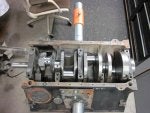I have heard that the HP of the 450sl went down and down over the years from 1972 to 1980, and I have always taken the Wikipedia specs as fact because they say:
1) Euro/ROTW 450sl / 450slc: 222 HP
*** from November, 1975 (change from D-Jetronic to K-Jetronic) rated at 217 PS (160 kW; 214 hp) @ 5000, from 1978 again at 225 PS (165 kW; 222 hp) @ 5000
^^^ I read as:
1a) 72-11/1975 = 222 HP
1b) 11/1975-1977 = 214 HP
1c) 1978-1980 = 222 HP
2) North American Spec (much less specific):
190 hp (142 kW) @ 4750
later 180 hp (134 kW) @ 4750
3) Collector car Magazine September 1985 says "bhp DIN" for the 450slc (m117) is 225* . The * then gets a note saying " *In US form, 230hp SAE 1972-76; 180hp 1977-79, 160hp 1980."
![Image]()
There are some notes in there that make many of the Collector Car magazine specs look accurate including the 155 HP for the US 3.8 and 160 hp for the 1980 4.5 L (a statistic that I recall reading somewhere), but you see there is a massive discrepancy between the numbers for the Early D-Jet North American models, 230hp vs. 190 hp.
I have only driven a 500sl and a 560sl, and recall thinking that there wasn't a ton more power. I had assumed that the difference between the 190hp and the 500sl/560sl HP might be hard for me too feel. So I assumed the 190 HP was correct. I also drove a 280sl 5-speed, an remembered it feeling quite lively, while definitely not the power of my 4.5L.
I don't know the conversion of "bhp DIN" to "hp", so maybe somehow that accounts for some of this discrepancy. In any case, I am curious to get to the bottom of it all.
So does anyone know the 4.5L hp specs really well? Is there a better source?
Of course I am especially interested in the specs of my 1973 4.5L.
EDIT: This came up because this popped right out to me as I opened the September 1985 edition of Car Collector that just showed up in my mailbox.
1) Euro/ROTW 450sl / 450slc: 222 HP
*** from November, 1975 (change from D-Jetronic to K-Jetronic) rated at 217 PS (160 kW; 214 hp) @ 5000, from 1978 again at 225 PS (165 kW; 222 hp) @ 5000
^^^ I read as:
1a) 72-11/1975 = 222 HP
1b) 11/1975-1977 = 214 HP
1c) 1978-1980 = 222 HP
2) North American Spec (much less specific):
190 hp (142 kW) @ 4750
later 180 hp (134 kW) @ 4750
3) Collector car Magazine September 1985 says "bhp DIN" for the 450slc (m117) is 225* . The * then gets a note saying " *In US form, 230hp SAE 1972-76; 180hp 1977-79, 160hp 1980."

There are some notes in there that make many of the Collector Car magazine specs look accurate including the 155 HP for the US 3.8 and 160 hp for the 1980 4.5 L (a statistic that I recall reading somewhere), but you see there is a massive discrepancy between the numbers for the Early D-Jet North American models, 230hp vs. 190 hp.
I have only driven a 500sl and a 560sl, and recall thinking that there wasn't a ton more power. I had assumed that the difference between the 190hp and the 500sl/560sl HP might be hard for me too feel. So I assumed the 190 HP was correct. I also drove a 280sl 5-speed, an remembered it feeling quite lively, while definitely not the power of my 4.5L.
I don't know the conversion of "bhp DIN" to "hp", so maybe somehow that accounts for some of this discrepancy. In any case, I am curious to get to the bottom of it all.
So does anyone know the 4.5L hp specs really well? Is there a better source?
Of course I am especially interested in the specs of my 1973 4.5L.
EDIT: This came up because this popped right out to me as I opened the September 1985 edition of Car Collector that just showed up in my mailbox.








